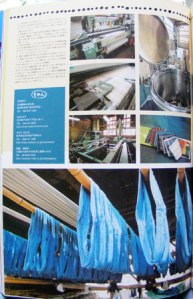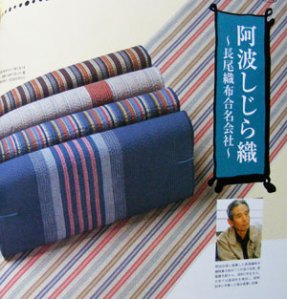Known for its distinctive crinkled, crepe-like texture, Awa Shijira-ori* is a cotton fabric ideal for making summertime yukata. The texture, similar to seersucker, does not stick to the skin in Japan’s hot, humid summers, and the openness of the weave allows for good airflow.

Originating in the Tokushima Prefecture during the Meiji era (1868-1889), it is believed that the Awa Shijira-ori’s unique texture was discovered by accident when cloth was left out in the rain, then dried in the sun. As the fabric shrank, it developed an uneven texture of puckers, known as shibo. This shrinkage was caused by different tension between the warp threads, similar to how chirimen is made.
From Traditional Crafts of Japan, Volume 1, Textiles:
Basically, a set of yarns with a tight tension is alternated with one [that has] fewer yarns and less tension. The latter set of yarns will be drawn up by the tighter set when the cloth is finished, thus producing a crepe texture. Maintaining this imbalance in tension when dressing the loom in an essential element in the creation of a shijira cloth having textural interest.
To give a general overview, however, the important manufacturing processes may be listed as follows: reeling, scouring, dyeing and rinsing, sizing, drying, twisting of the yarn; warping of the yard and dressing of the loom; weaving; removal of the cloth from the loom; crepeing, sizing and drying, measuring, and finally rolling the cloth onto one tan (eleven meters, the length needed to make one kimono) bolt.
Awa denotes the ancient name for the Tokushima Prefecture. This area has long been known for indigo cultivation, and Awa Shijira-ori is most often dyed with indigo. This image from issue # 3 of Kimono Hime shows mechanized looms, dye vats and reels of indigo-dyed cotton thread drying in the sun.
By the end of the 19th century, production was around two million bolts of fabric a year. Today only four family factories produce several thousand bolts annually of this interesting textile. I will be listing some yardage of the fabric at the top later today.
*Ori means “to weave” in Japanese (as used in shibori and origami it means “to fold”).



Interesting article about shijira-ori, and as I have to deal with those hot, uncomfortable summers I am quite interested in finding out more about this!
Just a linguistic quibble: ori in this case does indeed mean weave, and the ori in origami (written with a different Chinese character) is fold, but shibori is a quite different word, meaning squeeze or wring out.
Thank you for the clarification, Barney. I was thinking in terms of itajime shibori where the fabric is folded and clamped, but considering I hadn’t started studying kanji at the time I wrote this, I didn’t have a grasp of the language to that depth. 絞り does begin with the symbol for “to wring or twist”. I guess it all comes down to manipulating fabric?